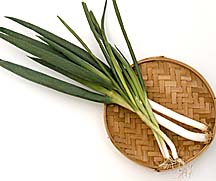
Eleanor Nakama-Mitsunaga
![]()
|
Green onions are probably the most common fresh onion used around the world. Although we are familiar with the thin, long, green stalks in supermarkets year-round, there are some subtle differences in varieties.
The basics: Green onions, also known as scallions or negi (in Japanese), are a type of onion that does not form a bulb. There is a slight difference between green onions and true scallions, but the two are commonly used interchangeably.
The giant naganegi dwarfs regular green onions.
Leeks, on the other hand, may look like giant green onions, but are a different variety of fresh onion entirely, generally milder in flavor. Chives, both European and Asian varieties, are related to green onions but are not the same. Chives may resemble a mini-green onion, but do not possess the thick white stem.
On occasion, a giant green onion pops up in Asian markets or farmer's market stalls here. This is a Japanese variety of green onion called naganegi (long onion), or Tokyonegi.
Kenneth Milner of North Shore Produce Grower produces the giant onion locally. He says the naganegi takes six months to reach maturity, a long time for a green onion, which makes it more expensive and more of a restaurant than retail item, although he does supply Daiei stores.
Although the entire onion is used, it is prized for its white stalk. It is grown with a mound of soil piled around the stem to promote a strong stalk.
Naganegi is technically a variety of green onion called bunching onions, with a very straight stalk. It is almost always cooked and not consumed raw. When cooked it has a very sweet flavor.
All varieties of green onion are a source of vitamin C.
Selecting: Greens onions are generally sold in bunches, while naganegi is sold by the stalk. Look for fresh, bright green tops and a firm, white stalk. Watch out for limp stalks.
Storing: All varieties of green onions may be stored in the refrigerator for up to five days. Keep them in plastic bags.
Use: The green and white parts of common green onions may be used raw or cooked for everything from garnishing a salad to flavoring a stir-fry dish. Stalks should be rinsed and dried before use.
The entire naganegi stalk may be also be used, but the white portion is what is favored for grilling and broiling, simmering, stir-frying and flavoring soups.
Where to buy: Green onions are abundant at all supermarkets, priced at 89 cents to $1 a bunch.
Naganegi is found sporadically, primarily in the summer, at Asian markets, and is pricier at up to $4 a pound.
If you're looking for a bargain on the naganegi, North Shore Produce Grower sells them for $1 a stalk at the Saturday Farmer's Market at Kapiolani Community College.
Eleanor Nakama-Mitsunaga is
a free-lance food writer. Contact her
online through features@starbulletin.com


